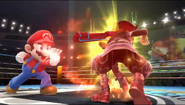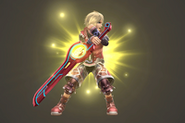Monado Arts (モナドアーツ Monado Arts?) is Shulk's Neutral Special Move. Shulk chooses from one of five arts which affect his physical traits.
Overview[]
Shulk activates the Monado Arts by summoning its kanji before calling out the name of the Art. As a visual indicator for each active Art, a colored glow will envelop parts of Shulk's character, and the kanji and name of the Art will appear beside Shulk's portrait (Wii U version only):
- 翔 (Jump, Shou): increased jump height, increased air speed, increased falling speed, increased Air Slash height, lower defense. The visual indicator is a green glow around Shulk's shoes.
- 疾 (Speed, Shitsu): increased ground speed, increased air speed, decreased attack power, decreased jump height. The visual indicator is a blue glow around Shulk's shoes.
- 盾 (Shield, Tate): increased defense, increased weight, increased shield health, decreased ground speed, decreased air speed, decreased jump height, decreased attack power. The visual indicator is a yellow glow around Shulk's body.
- 斬 (Buster, Zan): increased attack power, decreased launching power, decreased defense. The visual indicator is a purple glow around the Monado.
- 撃 (Smash, Geki): increased launch power, decreased attack power, decreased weight. The visual indicator is a red glow around Shulk's hands.
Activating the ability will cycle between the powers, in the order shown above, repeating after it's run through. In Super Smash Bros. Ultimate, Shulk instead selects a power by inputing a direction while holding down the special button. After some time, Shulk's selected buff will wear off. Alternatively, the player can cancel the current buff by pressing the button three times. If the player keeps pressing, the abilities will start the cycle again. Shulk can not use the same buff over and over, as there is a cooldown of 10 seconds for each ability after wearing off or being canceled. Each Art lasts 16 seconds (after that his stats return to normal). Shulk can continue to cycle through the buffs even if he starts moving or attacking (to a limited degree), or even if he comes under attack.
In Jump state, Shulk will take 1.22 times the normal damage. Jump is useful for edgeguarding, as it improves air movement and will even make Shulk go higher with Air Slash. This mode can be useful against floaty characters, but the player must be careful not to use Jump in order to leap onto someone who's on the ground, as they can counter with an Up Tilt or Up Smash.
In Speed state, Shulk will deal 0.80 times his normal damage damage. It is useful for rapidly approaching an enemy, grabbing, and accumulating damage at low risk early on. However, with lower jumps the player can pull more effective gimping combos with Neutral and Forward Aerials, and while the weaker attack damage is not so good, Shulk can string those aerials together into his Neutral Attack, Tilts and even Grabs. While in this mode Shulk's running speed is almost as high as Sonic's.
In Shield state, Shulk will take 2/3 normal damage, deal 0.70 times his normal damage and becomes the heaviest character in the game during the duration of the Art. A huge drawback of this state is that Shulk loses a lot of aerial acceleration, which can make recoveries extremely difficult. It should not be used at lower percentages, and despite the reduced damage intake, it succeeds mainly in making Shulk easier to land combos on. It is, however, a very useful ability, as it makes Shulk much harder to launch. In 1 x 1 stock battles, if the Shulk player has a stock advantage, it can help the player do more damage to the opponent before being KO'd, evening the stocks.
In Buster state, Shulk will deal 1.40 and take 1.13 times his normal damage. This should only be used if the Shulk player is not facing a tough opponent. It is a high risk, high reward stance that rewards skilled players who mastered the art of dodging and intercepting. It is usually better to use Buster against slower characters, as faster characters can easily retaliate and end up causing more damage than Shulk would.
Smash state should only be used if Shulk is on low percentages, as it can backfire if misused. Also, should only be used when the enemy is higher than 70%-80%, as it cuts Shulk's damage dealt in half. However, his Launch Power becomes so high to the point of being able to KO opponents with Throws (specially his Down Throw). Usually Smash should be only used as a "finisher", when the opponent is at a considerable high percentage enough to be dispatched earlier than they otherwise would.
If the player is launched away from the stage at Shield state to a point from which Shulk couldn't normally recover, try to press the special button 4 times quickly. If done correctly, it will put Shulk in Jump state. Saving Shulk's midair jump for this state is often needed for returning to the stage.
Changing powers makes Shulk vulnerable, because he cannot shield, dodge, or use his recovery move until an art has been chosen. Shulk cannot use Monado Arts on the respawn platform.
If timed correctly, Shulk can cancel any Aerial attack with a Monado Art, this is good for follow-ups. It is called Monado Art Landing Lag Cancel, or MALLC for short.
Any Monado Art that is still active while he activates his Final Smash, Chain Attack, will affect the outcome of the attack. For instance, Buster will deal more damage than the regular Final Smash, but will not launch opponents as far.
If Kirby swallows Shulk and gains the Monado Arts, his moves will be affected in the same way by the art chosen, including his Final Smash.
| Shulk's Special Moves | |||
|---|---|---|---|
| 3DS/Wii U | Ultimate | ||
| Standard Special | Monado Arts | ||
| Side Special | Back Slash | ||
| Up Special | Air Slash | ||
| Down Special | Vision | ||
| Final Smash | Chain Attack | ||
Custom Variations[]
Decisive Monado Arts[]
Decisive Monado Arts is one of Shulk's Neutral Special Moves that can be used via customizations. Shulk uses the Monado Arts to increase his stats in battle. The selected Art lasts longer and positive effects are stronger, but cannot be cancelled or switched with another Monado Art once used.
Strengths
- Longer duration
- Shorter recharge
- Positive effects are stronger.
Weaknesses
- Cannot be cancelled.
- Cannot switch into another Monado Art once activated
- Drawbacks last longer
Decisive Monado Arts grants Shulk the ability to take advantage of a certain Art due to its longer duration and increased strengths. However, Shulk will be unable to cancel them or switch to another Art, which can be problematic once the Art becomes disadvantageous, particularly since the drawbacks last longer. The window for selecting a Monado Art is slightly longer to allow Shulk to choose which Art to commit to.
Hyper Monado Arts[]
Hyper Monado Arts is one of Shulk's Neutral Special Moves that can be used via customizations. Shulk uses the Monado Arts to increase his stats in battle. The strengths and drawbacks are stronger, but they have a shorter time.
Strengths
- Positive effects are drastically stronger
Weaknesses
- Drawbacks are drastically stronger
- Shorter duration
- Longer recharge time
Hyper Monado Arts is a high-risk, high-reward move for Shulk, as it drastically increases the strengths of each Art, which can rival the natural strengths of other characters. As a downside, the drawbacks are much stronger, which can drastically negate any of Shulk's abilities while in the selected Art, and the short duration requires Shulk to take advantage of the Art quickly.
| Shulk's Custom Special Moves | ||
|---|---|---|
| Custom 1 | Custom 2 | |
| Standard Special | Decisive Monado Arts | Hyper Monado Arts |
| Side Special | Back Slash Leap | Back Slash Charge |
| Up Special | Advancing Air Slash | Mighty Air Slash |
| Down Special | Dash Vision | Power Vision |
Origin[]
In Xenoblade Chronicles, Shulk could use the Monado to enhance the abilities of himself and his party. He unlocked more arts as the story went along, some Arts were important to the plot, as he unlocked the Shield art just in time to save Reyn. Some Arts like Jump and Smash are exclusive to Smash Bros.
Trivia[]
- The Monado Arts may influence with his Final Smash and give more or less damage and knockback.
- Buster plays more like Enchant from Xenoblade Chronicles, emitting purple aura and giving damage boost, whereas Buster is an attack.
- Shield plays more like Armor from Xenoblade Chronicles, emitting a gold aura and damage reduction, whereas Shield is a one use protection against talent arts.







